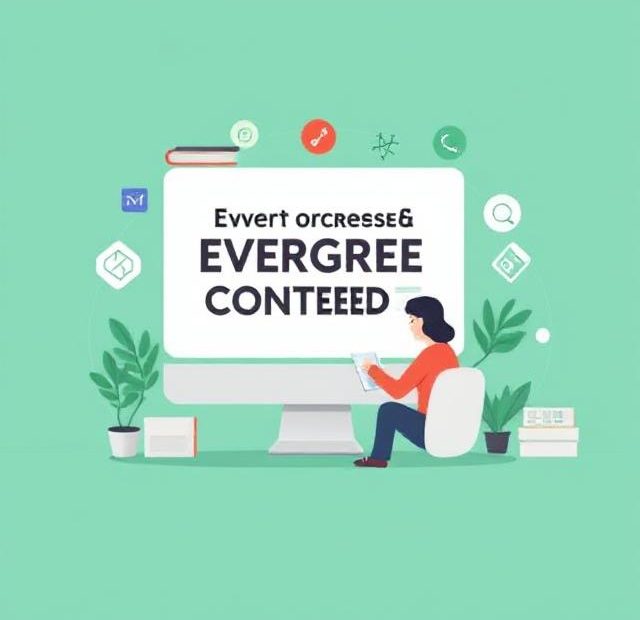When it comes to content marketing and SEO, trends change constantly. Algorithms get updated. Search intent shifts. New competitors emerge. But one thing remains consistent: evergreen content continues to be one of the most valuable assets for long-term SEO success.
Unlike trending or time-sensitive articles, evergreen content stays relevant for years, bringing in traffic, backlinks, and conversions long after it’s published. But creating truly evergreen content isn’t as simple as writing a blog post and hitting “publish.” It requires strategy, planning, and a clear understanding of what your audience will always care about.
In this guide, we’ll break down what evergreen content is, why it matters for SEO, and how to create it effectively.
What is Evergreen Content?
Evergreen content refers to content that remains useful, relevant, and valuable over time—regardless of season, trends, or news cycles. It answers core questions, solves ongoing problems, or teaches foundational concepts that don’t change much.
Common Examples of Evergreen Content:
-
How-to guides (“How to Start a Blog”)
-
Tips and tutorials (“10 Ways to Save Money on Groceries”)
-
Educational resources (“What is SEO?”)
-
Case studies with lasting value
-
Glossaries or definitions of key industry terms
Non-Evergreen (Time-Sensitive) Examples:
-
News articles
-
Event recaps
-
Trend predictions for a specific year
-
Product launch announcements
Why Evergreen Content is Powerful for SEO
Creating evergreen content isn’t just about writing articles that age well. It’s about building assets that work for you over time. Here’s how it helps your SEO:
1. Sustained Organic Traffic
Once evergreen content ranks well in search engines, it can continue to bring in traffic for months or even years without needing major updates.
2. Earns Backlinks Over Time
Because it stays relevant, evergreen content is more likely to be referenced and linked to by other sites, improving your domain authority.
3. Lower Maintenance
While you should refresh your evergreen content occasionally, it doesn’t need constant rewrites like trend-based content does.
4. Improved User Experience
Good evergreen content often addresses pain points, making it extremely valuable for new visitors and reducing bounce rates.
How to Create Evergreen Content That Ranks
Now that you know the value of evergreen content, let’s dive into how you can actually create it.
1. Identify Evergreen Topics in Your Niche
Start by brainstorming core questions your audience always asks. Use keyword research tools (like Ahrefs, SEMrush, or Google’s Keyword Planner) to find long-term, consistent queries. Look for:
-
High search volume
-
Low to moderate keyword difficulty
-
Long-tail keywords with clear intent
Examples:
-
For fitness: “How to lose belly fat”
-
For finance: “How to build an emergency fund”
-
For marketing: “What is a content strategy?”
Avoid topics tied to a year or specific event unless you plan to keep them updated.
2. Create Comprehensive, In-Depth Content
Search engines favor comprehensive, well-structured content that fully answers a query. If your piece is more helpful than your competitors’, it’s more likely to rank.
Tips:
-
Break content into clear sections with descriptive subheadings
-
Use bullet points, numbered lists, and visuals to improve readability
-
Cover related questions people also ask (check Google’s PAA boxes)
Aim for quality over quantity, but don’t be afraid to go deep. Many evergreen articles range from 1,000–2,500 words.
3. Write for Beginners (But Add Value for Experts)
Evergreen content often serves users at the top or middle of the funnel—those searching for foundational knowledge. However, that doesn’t mean it should be shallow.
Structure your content so that:
-
Beginners find it accessible and easy to understand
-
Experienced readers still find advanced tips, insights, or resources
A layered approach increases dwell time and shareability.
4. Use Clear, SEO-Friendly Formatting
Search engines need to understand your content structure. Follow these best practices:
-
Use a single H1 for the main title
-
Break down content with H2s and H3s
-
Use relevant keywords in headings, but naturally
-
Include internal links to related content on your site
-
Add meta descriptions and alt text for images
Also, make sure the page loads quickly and is mobile-friendly—Google considers these in ranking.
5. Update Content Periodically
Evergreen doesn’t mean “never touch it again.” Markets change. Tools go obsolete. New stats emerge.
Set a reminder to review top-performing evergreen posts every 6-12 months. Update:
-
Outdated tools or techniques
-
Broken links
-
New SEO best practices
-
Fresh examples or visuals
Even a small refresh can boost rankings and maintain your authority.
6. Promote Your Evergreen Content
Don’t just publish and hope for the best. Share evergreen posts:
-
On social media (multiple times, not just once)
-
In your email newsletter
-
On forums or groups where your audience hangs out
-
As internal links in new blog posts
Evergreen content is meant to be reshared. Since it doesn’t expire, it fits in any promotion calendar.
7. Track Performance Over Time
Use tools like Google Analytics and Google Search Console to monitor:
-
Organic traffic trends
-
Top-performing keywords
-
Engagement metrics (bounce rate, time on page)
If you notice traffic starting to dip, it may be time for a content refresh or technical SEO update.
Conclusion: Evergreen Content is an SEO Investment
Creating evergreen content isn’t a quick win—it’s a long-term investment in your brand, authority, and organic traffic. It takes more thought and effort upfront, but the results compound over time.
To recap:
-
Focus on timeless topics your audience always cares about.
-
Write clear, comprehensive, well-structured content.
-
Keep it optimized, updated, and actively promoted.
The payoff? You build a content library that continues to attract, educate, and convert readers for years to come.
Ready to start building evergreen assets for your site? Choose one topic from your niche today and begin planning a piece that will stand the test of time.
Also, you can learn more about Using Heading here.
